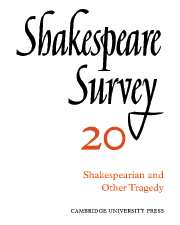Book contents
- Frontmatter
- Shakespeare, Fletcher and Baroque Tragedy
- Seneca and the Elizabethans: A Case-study in ‘Influence’
- George Chapman: Tragedy and the Providential View of History
- Critical Disagreement about Oedipus and Hamlet
- Shakespeare’s Thematic Modes of Speech: ‘Richard II’ to ‘Henry V’
- Anarchy and Order in ‘Richard III’ and ‘King John’
- The Staging of Parody and Parallels in ‘I Henry IV’
- Shakespeare’s Unnecessary Characters
- Walter Whiter’s Notes on Shakespeare
- Shakespeare’s ‘Romeo and Juliet’: Its Spanish Source
- The Grieves Shakespearian Scene Designs
- Shakespeare on the Modern Stage: Past Significance and Present Meaning
- Shakespeare in Brazil
- Recent Shakespeare Performances in Romania
- Shakespeare, the Twentieth Century and ‘Behaviourism’
- The Year's Contributions to Shakespearian Study 1 Critical Studies
- 2 Shakespeare’s Life, Times and Stage
- 3 Textual Studies
- Index
- Plate section
The Grieves Shakespearian Scene Designs
Published online by Cambridge University Press: 28 March 2007
- Frontmatter
- Shakespeare, Fletcher and Baroque Tragedy
- Seneca and the Elizabethans: A Case-study in ‘Influence’
- George Chapman: Tragedy and the Providential View of History
- Critical Disagreement about Oedipus and Hamlet
- Shakespeare’s Thematic Modes of Speech: ‘Richard II’ to ‘Henry V’
- Anarchy and Order in ‘Richard III’ and ‘King John’
- The Staging of Parody and Parallels in ‘I Henry IV’
- Shakespeare’s Unnecessary Characters
- Walter Whiter’s Notes on Shakespeare
- Shakespeare’s ‘Romeo and Juliet’: Its Spanish Source
- The Grieves Shakespearian Scene Designs
- Shakespeare on the Modern Stage: Past Significance and Present Meaning
- Shakespeare in Brazil
- Recent Shakespeare Performances in Romania
- Shakespeare, the Twentieth Century and ‘Behaviourism’
- The Year's Contributions to Shakespearian Study 1 Critical Studies
- 2 Shakespeare’s Life, Times and Stage
- 3 Textual Studies
- Index
- Plate section
Summary
During the quatercentenary celebrations at Stratford an exhibition was mounted at Hall’s Croft by Mr John Carroll of designs by the Grieves purporting to be for performances of Shakespeare’s plays. This exhibition first drew public attention to a collection of over six hundred Grieve stage designs in the University of London Library, from which a large proportion of the exhibits were drawn. A closer examination of this collection, however, reveals that only eight are actually assigned to Shakespeare plays in contemporary hands, though some others may well have been for performances for which the Grieves painted scenery. Unfortunately there is no evidence to substantiate these. Two hands are involved in the captions, excluding modern additions: one is small and generally in ink on the mounts; the other is large and either in ink or pencil, generally on the drawings themselves but occasionally also on the mounts. Even with the eight captioned designs a caveat must be entered: these are sketches and may have been considerably modified on the stage. All’s Well, however, is cut out as a model and ‘Shylock’s House’ is squared for enlargement.
- Type
- Chapter
- Information
- Shakespeare Survey , pp. 107 - 112Publisher: Cambridge University PressPrint publication year: 1967

